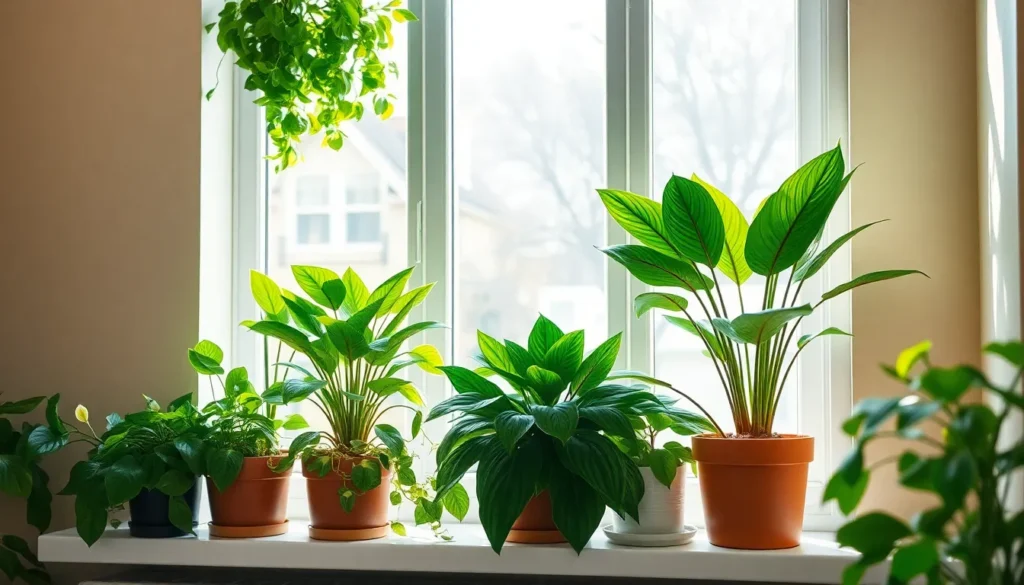We’ve all experienced that moment when we walk into a beautifully decorated space filled with lush greenery and wonder “What are those gorgeous plants?” Whether you’re a complete beginner or looking to expand your indoor garden collection knowing the names of popular houseplants opens up a industry of possibilities for creating your perfect green sanctuary.
Indoor plants aren’t just decorative elements – they’re living companions that purify our air boost our mood and transform any space into a vibrant oasis. From the dramatic fiddle leaf fig that makes a bold statement to the resilient snake plant that thrives on neglect each variety brings its own personality and care requirements to your home.
We’re here to demystify the industry of indoor gardening by introducing you to the most popular houseplants complete with their proper names care tips and unique characteristics. Ready to discover which green beauties will thrive in your space?
Low-Light Indoor Plants With Names for Dimly Lit Spaces
We’ve curated the perfect collection of resilient indoor plants that thrive in areas with minimal natural light.
Snake Plant (Sansevieria Trifasciata)
Snake plants stand tall as one of the most tolerant indoor plant varieties for low light conditions. These architectural beauties feature thick, upright leaves with striking yellow edges that can reach heights of 2-4 feet. We love how they purify air by removing formaldehyde and benzene while requiring water only every 2-3 weeks.
Neglect actually benefits snake plants since overwatering causes root rot faster than drought stress. Their succulent-like leaves store water efficiently, making them perfect for busy plant parents or frequent travelers. Bright indirect light helps them grow faster, but they’ll survive happily in office fluorescents or dim corners for months.
ZZ Plant (Zamioculcas Zamiifolia)
ZZ plants earn their reputation as virtually indestructible indoor companions that flourish in low light environments. Their glossy, dark green leaflets create an elegant cascading effect that adds sophistication to any room. We appreciate how these drought-tolerant plants can survive up to 4 weeks without water while maintaining their vibrant appearance.
Waxy leaf surfaces help ZZ plants reflect available light more efficiently than most houseplants. They grow slowly but steadily in dim conditions, producing new shoots from underground rhizomes that store nutrients and water. Office workers particularly love ZZ plants because they thrive under artificial lighting without requiring daily attention.
Pothos (Epipremnum Aureum)
Pothos vines adapt remarkably well to low light situations while producing those signature heart-shaped leaves we all recognize. These trailing plants work beautifully in hanging baskets or climbing up moss poles, reaching lengths of 6-10 feet indoors. We find their golden, marble queen, and neon varieties add instant color to darker spaces without demanding bright windows.
Versatility makes pothos ideal for beginners since they tolerate both underwatering and overwatering better than most plants. Their aerial roots grab onto surfaces naturally, creating living wall decorations that purify air by removing common household toxins. Water propagation allows us to create new plants easily by placing cuttings in glasses around our homes.
Peace Lily (Spathiphyllum)
Peace lilies communicate their needs clearly through dramatic leaf drooping when they need water, making plant care almost foolproof. These elegant flowering plants produce white spathes that bloom for several weeks, even in low light conditions where most flowering plants struggle. We value their ability to remove ammonia, benzene, and formaldehyde from indoor air while thriving in bathrooms and offices.
Humidity loving peace lilies appreciate regular misting or placement near humidifiers, especially during winter months. Their dark green foliage provides lush tropical appeal that brightens dim corners without requiring direct sunlight. NASA studies consistently rank peace lilies among the top air purifying plants for indoor environments.
Easy-Care Indoor Plants With Names for Beginners
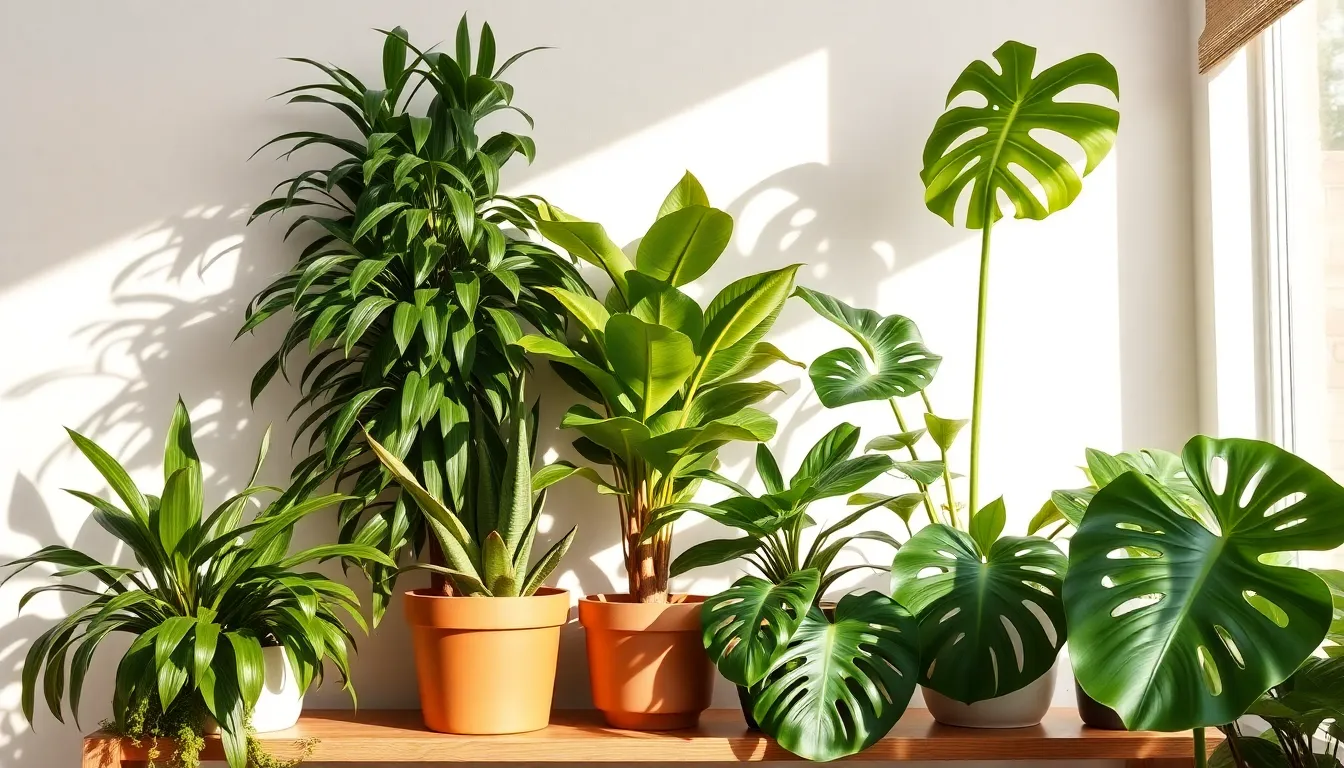
Building on our low-light selections, we’re now exploring beginner-friendly plants that combine stunning visual appeal with minimal care requirements. These resilient varieties offer perfect starting points for new plant parents seeking reliable green companions.
Spider Plant (Chlorophytum Comosum)
Spider plants captivate us with their arching leaves and remarkable air-purifying qualities that cleanse indoor environments naturally. We love how these resilient beauties thrive in bright to moderate indirect light without demanding constant attention. Watering becomes effortless since we simply allow soil to dry out between watering cycles, making overwatering nearly impossible.
Tolerance for occasional neglect makes spider plants exceptionally beginner-friendly choices for busy households. We appreciate their ability to produce cascading baby plantlets that create stunning hanging displays while offering opportunities for propagation. Growth patterns remain predictable and manageable, requiring minimal intervention from new plant parents.
Rubber Tree (Ficus Elastica)
Rubber trees impress us with their large, glossy leaves that create bold statements in any indoor space. We find these hardy plants adapt beautifully to bright, indirect light while tolerating lower light conditions when necessary. Watering requirements stay simple as we check the top inch of soil and water only when it feels dry.
Slow indoor growth makes rubber trees perfect for beginners who want substantial plants without rapid size changes. We recommend these low-maintenance beauties for their forgiving nature and ability to bounce back from minor care mistakes. Durability ensures long-term success even for those still learning proper plant care techniques.
Aloe Vera (Aloe Barbadensis Miller)
Aloe vera combines medicinal properties with succulent beauty, offering us both practical benefits and attractive indoor greenery. We position these plants in bright, indirect sunlight or areas receiving some direct sun for optimal growth. Watering becomes incredibly simple since we let soil dry out completely before providing moisture.
Drought tolerance makes aloe vera virtually indestructible for beginning plant enthusiasts who often worry about proper watering schedules. We value these succulents for their healing gel that soothes minor burns and skin irritations naturally. Care requirements remain minimal, making them perfect choices for people seeking functional beauty in their homes.
Monstera Deliciosa (Swiss Cheese Plant)
Monstera deliciosa earns fame through its large, perforated leaves that create dramatic focal points in modern interiors. We place these adaptable plants in bright, indirect light while knowing they’ll tolerate moderate shade conditions gracefully. Watering stays straightforward as we check the top inch of soil and provide moisture when dry.
Adaptability makes monsteras incredibly forgiving for beginner plant keepers who are still mastering care routines. We admire their unique fenestrated leaves that develop more dramatic splits as plants mature over time. Growth patterns remain manageable indoors, allowing new plant parents to enjoy stunning tropical aesthetics without overwhelming maintenance demands.
Air-Purifying Indoor Plants With Names for Better Air Quality
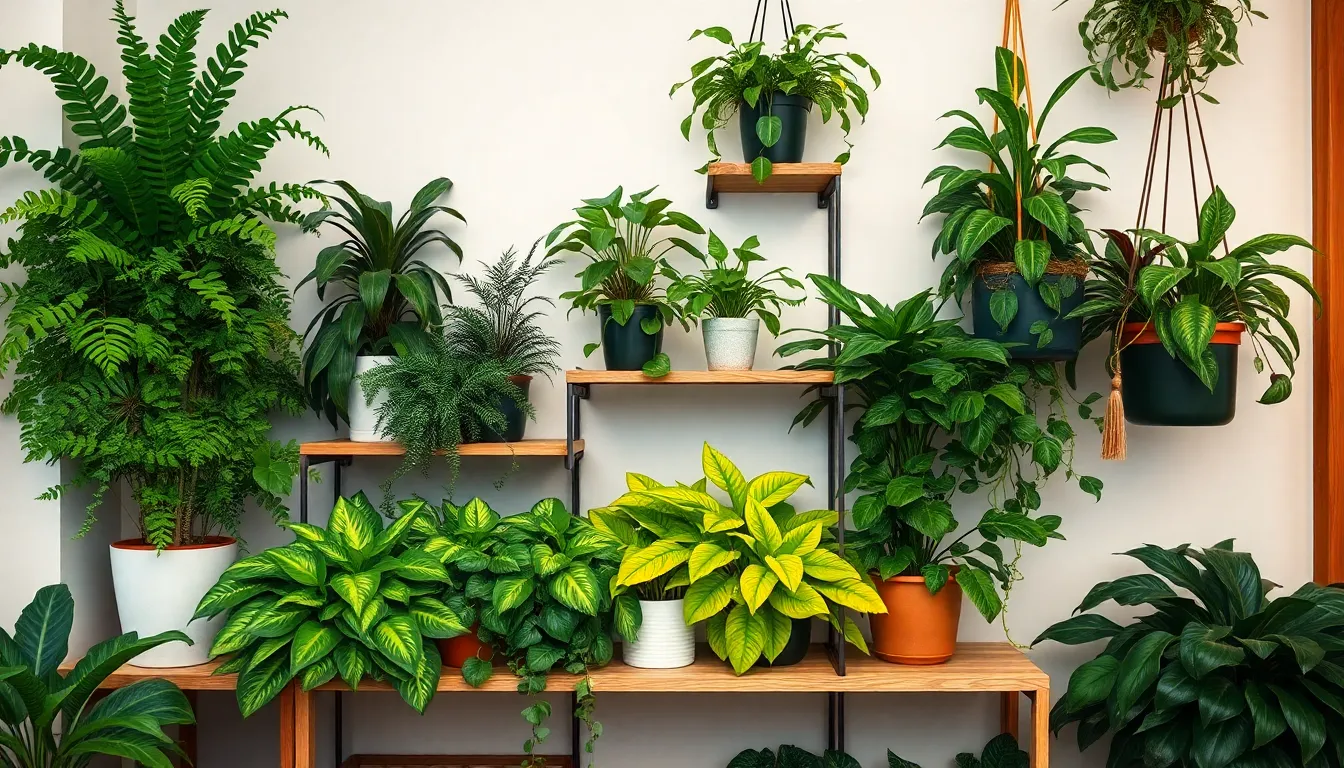
Moving beyond visual appeal, certain indoor plants excel at actively cleaning our home’s air while adding natural beauty to our spaces. NASA’s research has identified exact plant varieties that effectively remove common indoor pollutants like formaldehyde, benzene, and xylene from our living environments.
Boston Fern (Nephrolepis Exaltata)
Boston Ferns thrive in indirect sunlight and serve as powerful natural air filters in our homes. These lush, feathery plants effectively remove pollutants including cigarette smoke, formaldehyde, toluene, xylene, and benzene from indoor environments. We’ll find they prefer humid conditions and require moderate maintenance to keep their cascading fronds healthy and vibrant.
Placement near bathrooms or kitchens works exceptionally well since these areas naturally provide the moisture Boston Ferns crave. Regular misting helps maintain the humidity levels these plants need to flourish while performing their air cleaning duties. Their graceful arching fronds create an elegant display whether placed on plant stands or in hanging baskets.
English Ivy (Hedera Helix)
English Ivy stands out for its remarkable ability to filter mold spores and airborne fecal particles from our indoor air. This versatile climbing plant thrives with moderate light conditions and significantly reduces airborne allergens throughout our homes. We can train it to climb supports or allow it to trail from elevated positions for maximum air purification coverage.
Research shows English Ivy particularly excels at removing formaldehyde and other volatile organic compounds commonly found in household cleaning products. Its heart shaped leaves work continuously to improve our indoor air quality while requiring minimal care. Growing this hardy plant indoors provides us with both decorative appeal and measurable health benefits.
Dracaena (Dracaena Marginata)
Dracaena species efficiently remove benzene, formaldehyde, trichloroethylene, and xylene from our indoor environments. These striking plants tolerate various indoor light conditions while adding dramatic architectural interest with their spiky, colorful foliage. We appreciate how they combine aesthetic value with powerful air purification capabilities.
Their slow growth pattern makes them ideal for long term indoor cultivation without overwhelming our spaces. Dracaena plants require minimal watering and can survive periods of neglect while continuously working to clean our air. The red edged leaves of Dracaena marginata create stunning visual contrast against walls or furniture.
Philodendron (Philodendron Hederaceum)
Philodendrons rank among our most reliable choices for absorbing formaldehyde and other common indoor toxins. These popular trailing plants require minimal maintenance while contributing significantly to healthier indoor atmospheres. We love how their heart shaped leaves cascade beautifully from shelves or hanging planters while actively purifying our air.
Their rapid growth and easy propagation make them excellent choices for expanding our air purifying plant collection. Philodendrons adapt well to various lighting conditions and forgive occasional watering mistakes. These resilient plants continue working around the clock to remove harmful chemicals from our homes while bringing natural beauty to any room.
Flowering Indoor Plants With Names for Colorful Displays
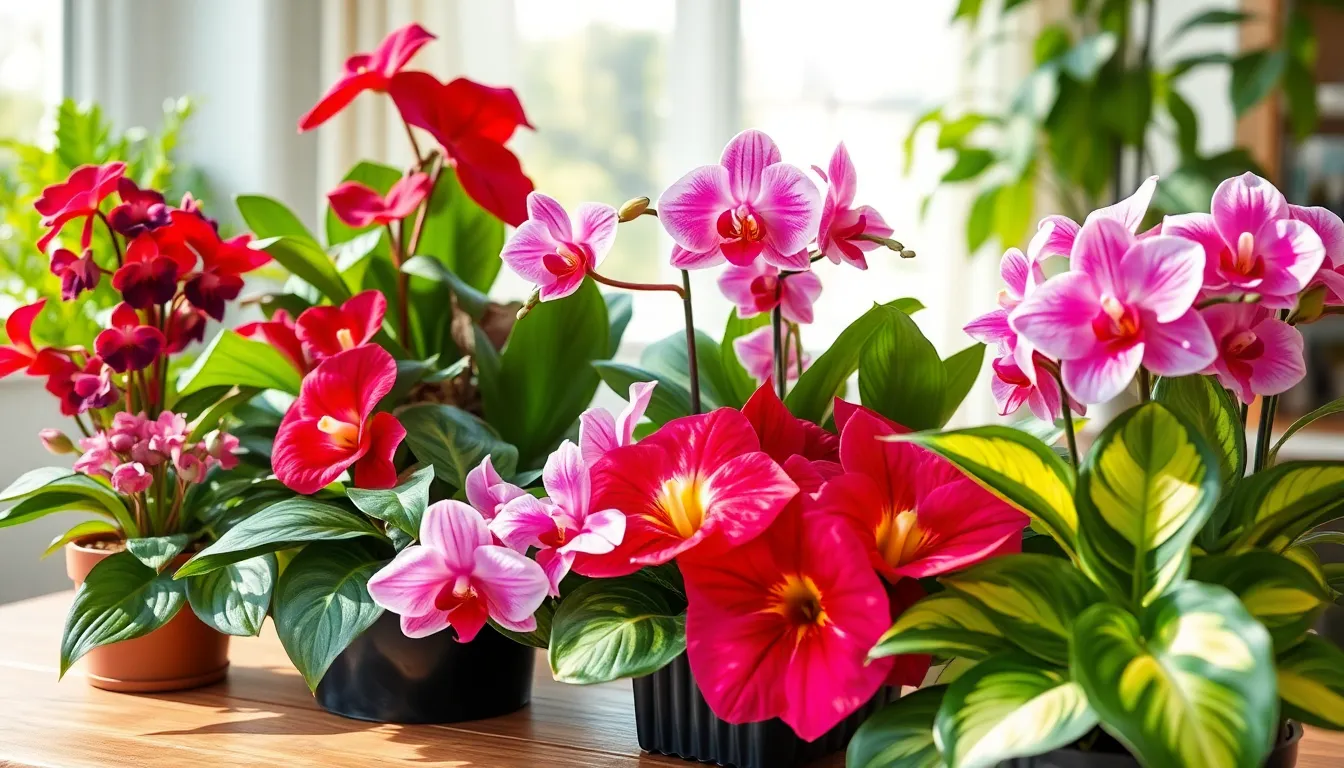
Adding vibrant blooms to your indoor garden creates stunning focal points that brighten any living space. These flowering varieties bring year-round color and beauty to complement your existing houseplant collection.
African Violet (Saintpaulia)
African violets stand out as beloved flowering houseplants with their velvety, fuzzy leaves and enchanting blooms in violet, purple, or pink shades. We love how these compact plants thrive in moderate indirect light without requiring a sunny windowsill like many other flowering varieties.
Consistent moisture keeps African violets happy, but they’ll quickly show distress if you waterlog their soil. Multiple blooming cycles throughout the year make these plants exceptional value for indoor gardeners seeking continuous color. Their manageable size fits perfectly on tabletops, shelves, or plant stands in any room of your home.
Anthurium (Anthurium Andraeanum)
Anthuriums deliver tropical elegance with their glossy, heart-shaped leaves and striking waxy spathes in brilliant red, pink, or white colors. Contrasting yellow spadixes create dramatic visual interest that instantly transforms any indoor space into an exotic retreat.
Bright indirect light suits these beauties perfectly, while high humidity keeps their foliage looking lustrous and healthy. Year-round blooming under proper care means you’ll enjoy constant tropical vibes in your home. We recommend placing anthuriums in bathrooms or kitchens where natural humidity levels support their growth requirements.
Orchid (Orchidaceae)
Orchids represent the ultimate in sophisticated indoor flowering plants, offering exotic blooms in countless colors, shapes, and patterns. Popular varieties include Phalaenopsis, Cattleya, Dendrobium, and Oncidium orchids, each bringing unique characteristics to your collection.
Bright, indirect light combined with moderate watering and excellent air circulation creates ideal growing conditions for these prized plants. Individual blossoms can last several weeks to months, providing exceptional longevity compared to cut flowers. We find orchids particularly rewarding because their elegant appearance elevates any room’s aesthetic while requiring surprisingly manageable care once you understand their preferences.
Begonia (Begonia Rex)
Begonias offer double the visual impact with both attractive blooms and stunning variegated foliage in shades of green, bronze, and silver. Rex begonias specifically showcase incredible leaf patterns while producing delicate flowers in red, pink, or white throughout the year.
Bright light without direct sun exposure keeps these plants thriving indoors, making them perfect for east or north-facing windows. Their transition from outdoor to indoor favorites happened because they adapt beautifully to household conditions while maintaining their colorful display. We appreciate how begonias provide constant visual interest even between blooming periods thanks to their ornamental foliage.
Succulent Indoor Plants With Names for Minimal Watering

Succulents offer the perfect solution for those seeking beautiful indoor plants that thrive with minimal water requirements. These drought tolerant varieties store water in their thick leaves and stems, making them ideal choices for busy plant enthusiasts.
Jade Plant (Crassula Ovata)
Classic charm defines this beloved houseplant that’s earned its reputation as one of the most reliable succulents for indoor growing. Thick, fleshy leaves store water efficiently, allowing the jade plant to survive weeks without watering. We recommend placing this hardy beauty in bright, indirect light where it’ll maintain its vibrant green color and compact growth pattern.
Popular among beginners and experienced plant parents alike, the jade plant adapts well to various indoor conditions while requiring minimal care. Its aesthetic appeal comes from glossy, oval shaped leaves that create an attractive bushy appearance perfect for tabletops or plant stands.
Echeveria (Echeveria Elegans)
Beautiful rosette formations make echeveria one of our most visually striking succulent recommendations for indoor spaces. Pastel colors ranging from blue green to purple create stunning displays that complement any home decor style. These compact plants thrive in bright, indirect light while requiring water only when their soil becomes completely dry.
Well draining soil prevents root rot, which is crucial for maintaining healthy echeveria plants indoors. We’ve found that these succulents perform best when placed near windows that receive filtered sunlight throughout the day.
String of Pearls (Senecio Rowleyanus)
Trailing elegance characterizes this unique succulent with its distinctive spherical leaves that resemble tiny green beads cascading from hanging containers. String of pearls creates dramatic visual impact when displayed in elevated positions where its vine like growth can flow freely. Sparse watering schedules suit this plant perfectly, as overwatering quickly leads to root problems.
Bright, indirect light keeps the pearl shaped leaves plump and healthy while maintaining their characteristic trailing habit. We suggest checking soil moisture levels before watering, as this succulent prefers completely dry conditions between waterings.
Haworthia (Haworthia Cooperi)
Hardy zebra patterns distinguish haworthia as an exceptional choice for indoor succulent collections, especially for those dealing with lower light conditions. Small size makes these plants perfect for desk displays, windowsills, or grouped arrangements with other succulents. Striped leaves create attractive geometric patterns that add visual interest to any indoor space.
Beginner friendly care requirements include minimal watering and tolerance for various light levels, making haworthia incredibly forgiving for new plant parents. We often see these resilient succulents thriving in restaurants and homes where they receive minimal attention yet continue producing new growth year after year.
Large Indoor Plants With Names for Statement Pieces
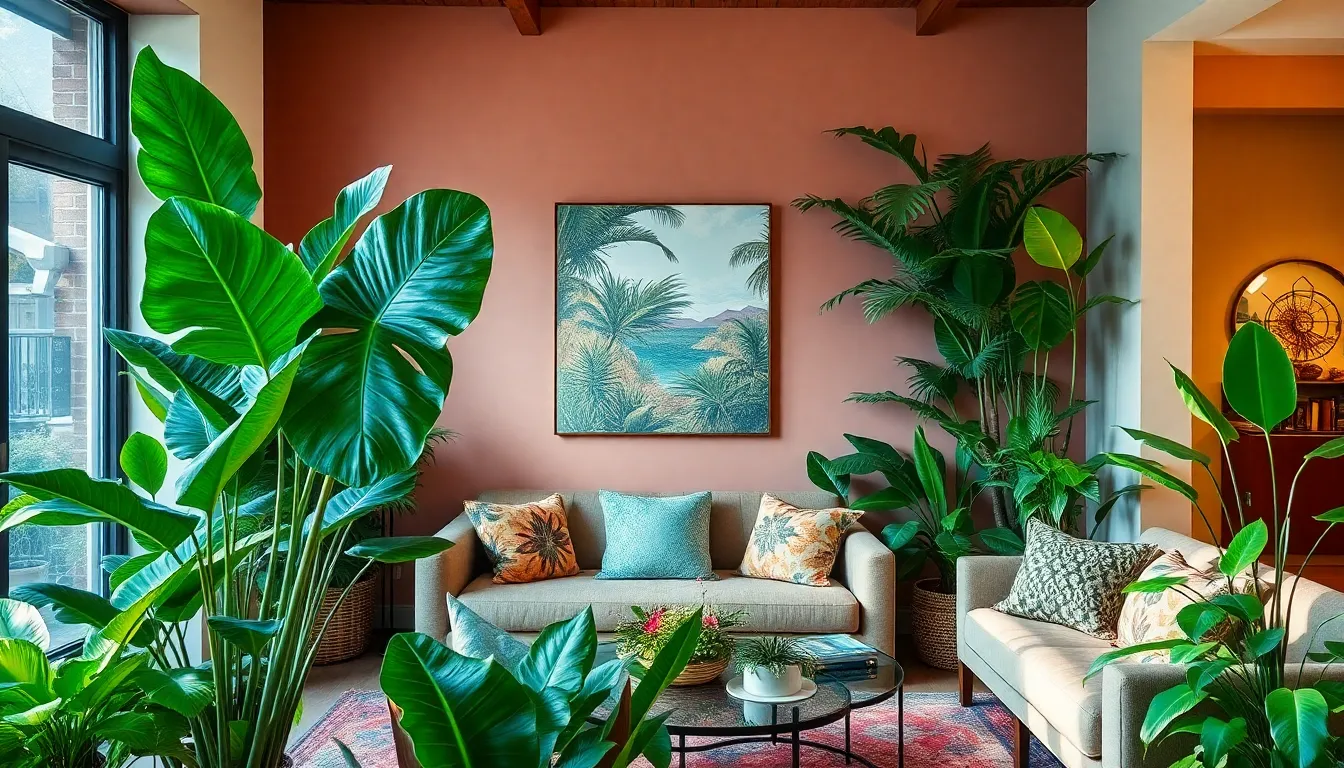
Now we’re exploring dramatic plants that serve as living sculptures and focal points in your indoor spaces. These large indoor plants with names transform ordinary rooms into stunning botanical showcases.
Fiddle Leaf Fig (Ficus Lyrata)
Fiddle Leaf Figs command attention with their distinctive large, waxy leaves shaped like violins. We love how these plants instantly elevate living rooms and entryways with their bold texture and impressive height. Most specimens grow several feet tall indoors, creating the perfect focal point for any room.
Care requirements include bright, indirect sunlight and careful watering practices. Allow the soil to dry out completely between waterings to prevent root rot. These plants thrive when positioned near north-facing windows where they receive consistent but filtered light throughout the day.
Bird of Paradise (Strelitzia Reginae)
Bird of Paradise plants feature stunning banana-like leaves that bring instant tropical vibes to indoor spaces. Giant Bird of Paradise (Strelitzia nicolai) varieties can reach over 5 feet indoors, making them ideal statement pieces for high-ceilinged rooms. Outdoor varieties produce striking orange and blue flowers, though indoor specimens focus primarily on dramatic foliage.
Light and water needs include bright, direct sunlight and low humidity conditions. Water these plants when the soil feels dry to the touch. Keep them away from pets since all parts are toxic if ingested.
Umbrella Tree (Schefflera Actinophylla)
Umbrella Trees showcase glossy, umbrella-like leaf clusters that radiate from central stems in perfect symmetry. These plants grow tall and bushy, filling large indoor spaces with lush greenery that creates natural room dividers. We recommend them for homeowners who want maximum visual impact with minimal maintenance effort.
Growing conditions favor medium to bright indirect light placement throughout your home. Keep the soil evenly moist but allow occasional dryness between waterings. These forgiving plants adapt well to various indoor environments while maintaining their striking appearance.
Norfolk Island Pine (Araucaria Heterophylla)
Norfolk Island Pines offer unique coniferous beauty with soft, symmetrical needle-like foliage resembling miniature pine trees. Their tall, slender growth pattern makes them perfect for corners or as living Christmas tree alternatives during holiday seasons. We appreciate how these plants bring year-round evergreen elegance to indoor spaces.
Optimal care involves bright, indirect light exposure and consistent watering without waterlogging the soil. Position these plants away from heating vents and maintain steady moisture levels. Their symmetrical growth pattern requires minimal pruning while delivering maximum visual impact.
Trailing Indoor Plants With Names for Hanging Baskets
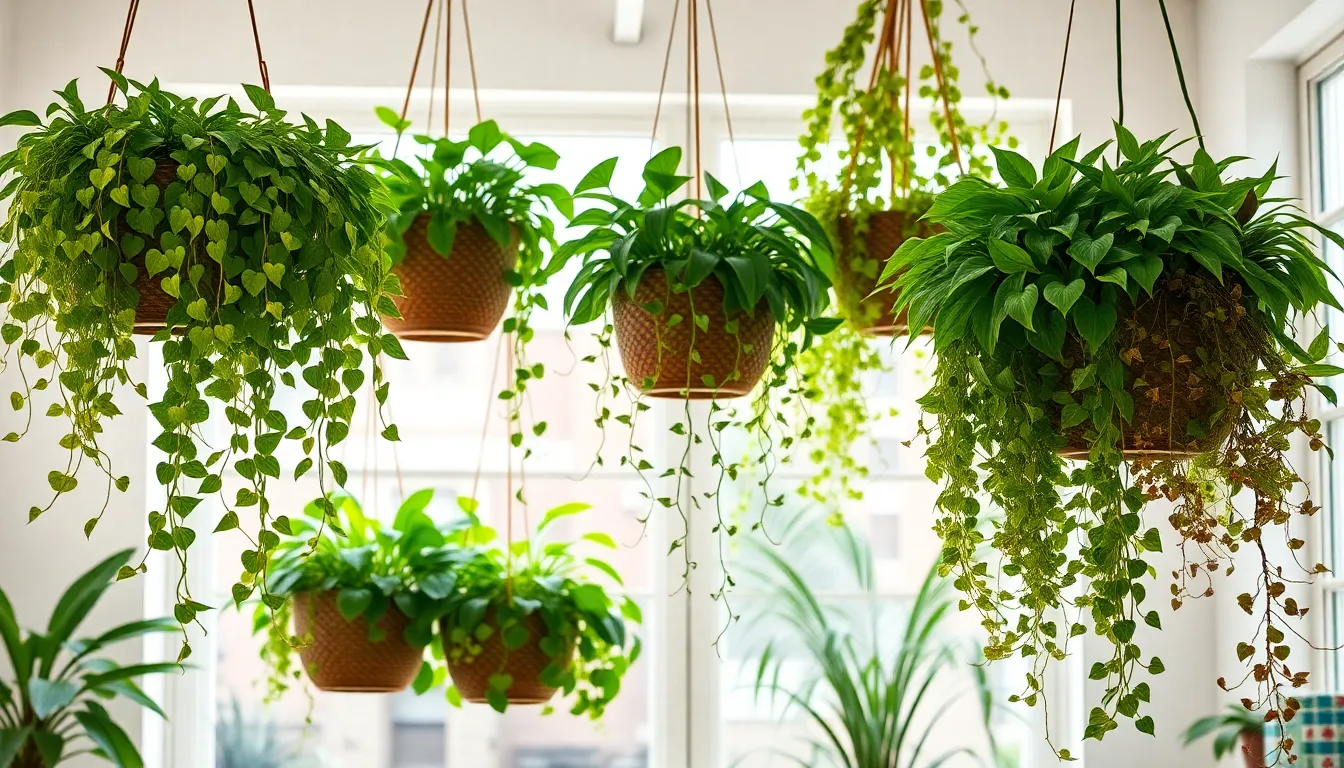
Cascading plants create stunning vertical displays that maximize our living spaces while adding natural elegance to any room. These trailing varieties thrive in hanging baskets and transform ordinary corners into captivating green sanctuaries.
String of Hearts (Ceropegia Woodii)
String of Hearts captivates us with its delicate heart-shaped leaves that cascade gracefully from thin trailing vines. This charming succulent displays small silver-speckled foliage that creates an enchanting waterfall effect in hanging baskets. We appreciate its slow but steady growth pattern that allows us to enjoy each new leaf as it develops along the vine.
Care requirements remain refreshingly simple for this eye-catching trailing plant. Bright indirect light keeps the distinctive heart-shaped leaves vibrant while preventing the thin vines from becoming leggy. Watering needs stay minimal since this plant stores moisture in its succulent leaves and tubers.
Propagation becomes effortless with String of Hearts since it naturally produces small tubers along its vines. We can easily create new plants by placing these tubers in soil while they’re still attached to the mother plant. This unique feature makes it perfect for sharing with friends or expanding our collection.
Devil’s Ivy (Epipremnum Aureum)
Devil’s Ivy stands out as one of the most adaptable and fast-growing trailing plants for indoor hanging baskets. Also known as Pothos, this hardy vine produces heart-shaped variegated leaves that thrive in various lighting conditions from low to bright indirect light. Its vigorous growth habit quickly fills hanging baskets with lush green foliage.
Maintenance stays incredibly low with this forgiving trailing plant that tolerates neglect. We can water it when the soil feels dry to the touch, and it’ll bounce back quickly even if we forget occasionally. The glossy leaves naturally repel dust and maintain their attractive appearance with minimal cleaning.
Versatility makes Devil’s Ivy perfect for different decorative arrangements throughout our homes. Its trailing vines can cascade several feet from hanging baskets or climb moss poles when we want vertical growth. The plant also propagates easily in water, allowing us to create multiple plants from a single vine.
Heartleaf Philodendron (Philodendron Scandens)
Heartleaf Philodendron graces hanging baskets with glossy heart-shaped leaves that trail elegantly over container edges. This classic houseplant produces smooth, dark green foliage that maintains its lustrous appearance year-round. We love how its graceful vines create beautiful cascading displays that soften harsh room corners.
Growing conditions remain straightforward for this reliable trailing philodendron variety. Moderate to bright indirect light keeps the leaves healthy and promotes steady growth along the trailing stems. Regular watering when the top inch of soil dries out maintains optimal health without risking root rot.
Air purifying qualities add functional benefits to this philodendron’s decorative appeal. Studies show it effectively removes common indoor pollutants while requiring minimal care from us. The plant’s ability to thrive in various humidity levels makes it suitable for different rooms throughout our homes.
Tradescantia (Tradescantia Zebrina)
Tradescantia zebrina dazzles us with its striking purple and silver-striped foliage that trails magnificently from hanging containers. This vibrant plant displays iridescent leaves with distinctive zebra-like patterns that catch light beautifully throughout the day. Each leaf shows unique coloration ranging from deep purple undersides to silver-green tops.
Fast growth makes this trailing plant perfect for quickly filling empty hanging baskets with colorful foliage. We can expect rapid vine development that creates full, lush displays within just a few months of planting. The speedy growth also means regular pinching helps maintain bushy, compact growth rather than sparse, leggy vines.
Propagation stays remarkably easy with Tradescantia since stem cuttings root quickly in water or soil. We can create new plants by simply cutting healthy vine sections and placing them in water until roots develop. This characteristic makes it an excellent choice for sharing with other plant enthusiasts or expanding our trailing plant collection.
Conclusion
We’ve explored an incredible variety of indoor plants that can transform any space into a thriving green sanctuary. From low-maintenance succulents to dramatic statement pieces each plant offers unique benefits that extend far beyond simple decoration.
Whether you’re drawn to air-purifying varieties that enhance your home’s atmosphere or stunning flowering plants that bring year-round color choosing the right indoor plants depends on your lifestyle and preferences. The trailing options we’ve covered create beautiful vertical displays while beginner-friendly selections ensure success for new plant parents.
Starting your indoor garden journey doesn’t require extensive experience or perfect conditions. With this comprehensive guide to indoor plants and their names you’re equipped to make informed decisions that’ll bring natural beauty and improved well-being into your living space.
Frequently Asked Questions
What are the best indoor plants for beginners?
Snake Plants, ZZ Plants, Pothos, and Spider Plants are excellent choices for beginners. These plants are extremely forgiving, require minimal watering, and can tolerate various light conditions. They’re low-maintenance yet visually appealing, making them perfect for new plant parents who want to build confidence before moving to more demanding varieties.
Which indoor plants can survive in low-light conditions?
Snake Plants, ZZ Plants, Pothos, and Peace Lilies thrive in dimly lit spaces. These resilient plants have adapted to survive with minimal natural light, making them ideal for offices, bathrooms, or rooms with limited windows. They maintain their beauty and health even in challenging lighting conditions.
What are the best air-purifying plants for my home?
According to NASA research, Boston Ferns, English Ivy, Dracaena species, and Philodendrons effectively remove indoor pollutants. These plants filter harmful substances like formaldehyde, mold spores, and allergens while adding natural beauty to your space. They’re particularly beneficial for improving indoor air quality in bedrooms and living areas.
Which indoor plants produce beautiful flowers?
African Violets, Anthuriums, Orchids, and Begonias are excellent flowering houseplants. African Violets offer charming purple or pink blooms, while Anthuriums provide striking heart-shaped spathes. Orchids deliver exotic sophistication, and Rex Begonias combine stunning variegated foliage with delicate flowers for year-round color.
What are the easiest succulents to grow indoors?
Jade Plants, Echeveria, String of Pearls, and Haworthia are perfect low-maintenance succulents. These plants require minimal watering, making them ideal for busy lifestyles. They offer unique textures and forms, from Jade Plant’s thick leaves to String of Pearls’ trailing appearance, while tolerating neglect better than most houseplants.
Which large plants make the best statement pieces?
Fiddle Leaf Figs, Bird of Paradise, Umbrella Trees, and Norfolk Island Pines create dramatic focal points. These impressive plants transform ordinary rooms into botanical showcases with their substantial size and striking foliage. They require more space but offer maximum visual impact for creating stunning indoor landscapes.
What are the best trailing plants for hanging baskets?
String of Hearts, Devil’s Ivy (Pothos), Heartleaf Philodendron, and Tradescantia excel in hanging displays. These cascading plants create beautiful vertical gardens with their flowing foliage. They’re perfect for adding elegance to any room while maximizing growing space through creative vertical arrangements.
How often should I water my indoor plants?
Watering frequency depends on the plant type, season, and environment. Most houseplants prefer soil that’s slightly dry between waterings. Succulents need water every 1-2 weeks, while tropical plants may require weekly watering. Always check soil moisture by inserting your finger 1-2 inches deep before watering.
Do indoor plants really improve air quality?
Yes, NASA studies confirm that many houseplants effectively remove common indoor pollutants including formaldehyde, benzene, and carbon monoxide. Plants like Boston Ferns, English Ivy, and Philodendrons actively filter air while releasing oxygen. However, you’d need multiple plants to significantly impact air quality in larger spaces.
What’s the best location for indoor plants in my home?
Most indoor plants thrive in bright, indirect light near windows but away from direct sunlight. Avoid placing plants near heating vents, air conditioners, or drafty areas. Bathrooms work well for humidity-loving plants like Boston Ferns, while living rooms with consistent temperatures suit most houseplants perfectly.

